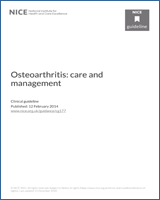NCBI Bookshelf. A service of the National Library of Medicine, National Institutes of Health.
National Clinical Guideline Centre (UK). Osteoarthritis: Care and Management in Adults. London: National Institute for Health and Care Excellence (UK); 2014 Feb. (NICE Clinical Guidelines, No. 177.)
Update information: December 2020: in the recommendation on adding opioid analgesics NICE added links to other NICE guidelines and resources that support discussion with patients about opioid prescribing and safe withdrawal management. For the current recommendations, see www.nice.org.uk/guidance/CG177/chapter/recommendations.
Summarised here is the CG59 cost consequences analysis.
A simplistic analysis was undertaken in CG59 for the interventions which cost-effectiveness remained uncertain, and full economic analysis was not available. The interventions included are; nutraceuticals, hyaluronan injections, and acupuncture.
Studies which reported total WOMAC scores for the interventions mentioned above were included, provided they had a sample size greater than 90. Includable studies also had to have an intervention and a placebo arm.
The interventions included in this analysis do not form an exhaustive list of the interventions for osteoarthritis that have resource implications. Other important economic areas are considered in more depth in the published literature (exercise therapy), or in this guideline (NSAIDs, Cox-2s). The interventions included here represented those interventions which are not considered in more detail elsewhere in the guideline, and which have substantial cost implications.
The analysis did not attempt to provide a full economic analysis of the interventions included, but instead presented the direct UK costs of the intervention alongside the efficacy of the intervention as found in the CG59 clinical evidence review. These estimates were used to calculate incremental cost effectiveness ratios for the interventions. These ICERs should be treated with care as they are often based on fairly scarce clinical evidence which had been transformed into a QALY score using the mapping method provided by Barton et al (which was not yet published during CG59).
M.1. Acupuncture
A summary of the acupuncture section of the cost consequences analysis can be found below in Table 8.
Table 8
Economic evidence profile: Acupuncture as an adjunct – based on sham acupuncture controlled trials (CG59 analysis).
Note that the CG59 cost conseqeuences analysis used RCTs with placebo comparisons, however given that no costs were included in the sham acupuncture arm, then this should be interpreted as a comparison with usual care, but using sham acupuncture controlled trials. As had it been a true sham comparison, it may be likely that the incremental costs would be zero as both acupuncture and sham use similar resources.
The cost consequences table only considers the direct costs of the intervention i.e. a 30 minute session by a community physiotherapist (or 20 minutes for Sangdee (2002)), and the cost of the needles. The sham arm is considered to have no costs. It does not consider adverse event costs, or decreased use of other medical resources because of increased well-being.
The analysis based on sham controlled trials showed acupuncture to be cost-effective only in one of the four trials (table 6). The outlier from this group is Witt (2005) which has a cost effective ICER of below £10,000.
Some possible explanations as to the variations in the ICERs include:
- The different time horizons: Witt (2005) has a time horizon of 52 weeks (i.e. followed patients up until 52 weeks after the start of the intervention), whereas the treatment was only given for 8 weeks. So this longer follow up time is capturing remaining beneficial effects of acupuncture after the treatment has ended.
- WOMAC scores: the clinical review shows that Witt (2005) is one of the studies that favours acupuncture the most (Pain WOMAC- short term- OA knee), but there is also high uncertainty surrounding this estimate.
M.2. Nutraceuticals
A summary of the nutraceuticals section of the cost consequences analysis can be found below in Table 9.
Table 9
Economic evidence profile: Nutraceuticals versus usual care – based on placebo controlled trials (CG59 analysis).
Note that this analysis has been entitiled as nutraceuticals versus usual care because placebo controlled trials were used, however patients may have been using other treatments as well, additionally costs of placebo were not included in the analysis.
The analysis only considers the direct costs of the intervention i.e. the cost of the drugs and assuming 1 GP consultations per year. It does not consider adverse event costs, or decreased use of other medical resources because of increased well-being.
The studies which use glucosamine sulphate all use preaprations which are now licensed. These studies are Pavelka, Reginster and McAlindon.
M.3. Hyaluronan intra-articular injections
A summary of the hyaluronans section of the cost consequences analysis can be found below in Table 10.
Table 10
Economic evidence profile: Hyaluronans vs usual care – based on placebo (saline) controlled trials (CG59 analysis).
Note that this analysis has been entitiled as hyaluronans versus usual care because placebo controlled trials were used, however patients may have been using other treatments as well, additionally costs of placebo were not included in the analysis.
The cost analysis only considers the direct costs of the intervention i.e. the cost of the injections plus the GP consultation to administer the injection. It does not consider adverse event costs, or decreased use of other medical resources because of increased well-being.
- CG59 cost consequences analysis - OsteoarthritisCG59 cost consequences analysis - Osteoarthritis
- Recommendations from NICE clinical guideline 59 (2008) that have been deleted or...Recommendations from NICE clinical guideline 59 (2008) that have been deleted or changed - Osteoarthritis
Your browsing activity is empty.
Activity recording is turned off.
See more...

